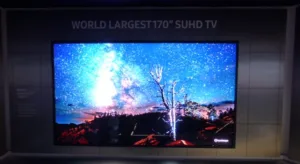Although only briefly mentioned in the press conference, the area garnering the most attention held Samsung’s 170″ TV. It is a concept model using a modular technology. Unlike the Evolution Kit and similar approaches, the display itself is modular. A small TV can have sections added to become larger, and on one side of the area a large display was transforming between a 16:9 aspect ratio and 21:9, by splitting in half and having the sections rotate.
Samsung was naturally very close-mouthed about the technology, simply confirming that it was not OLED. However, when the modules were moved apart, electronics similar to those on an LED tile were clearly visible behind the display surface. Apparently the concept was a very high-resolution LED display; we heard rumours of a 1mm pixel pitch or lower, but a barrier meant that we could not get close enough to confirm.
Other concept TVs were on show, including an 8k TV using quantum dots. Samsung has finally admitted that its ‘SUHD’ TVs use cadmium-free quantum dots as a colour boost. Last year the company insisted that the higher colour gamut was down to ‘nanocrystals’.
All of Samsung’s SUHD TVs this year will include quantum dots, as well as HDR capabilities, with ‘at least’ 1,000 cd/m² of peak brightness. A new ‘Ultra Black’ technology reduces light reflection. They will also feature an IoT hub, able to connect to and control any IoT device using Samsung’s SmartThings platform.
The KS9500 is the world’s first ‘bezel-less’ curved TV, although it does of course still have bezels; they are simply very thin. It is the flagship model, one of five new ranges of SUHD TVs to be launched this year, in 49″, 55″, 65″, 78″ and 88″. It was the only one of the new ranges on the stand, however – we’ll need to wait until later in the year to see Samsung’s other SUHD sets. The KS9500 uses an edge-LED backlight, unlike last year’s JS9500.
Nearby was Samsung’s UltraHD Blu-ray player, the UBD-K8500. This is an HDR-compatible model that follows the Blu-ray Disc Association’s UltraHD Blu-ray specifications. It can be pre-ordered in the USA today, and costs $400. It will be launched in March, when the price will jump to $500.
We heard after the event that Samsung has said that there will be no “Evolution kit” for its TV years. The company originally said that it would support upgradeable TVs until 2016, but seems to have moved back from that. There is talk of a software update for last year’s TVs.
Although mobiles are no longer a big part of Samsung’s CES presence, the company did find space for a new notebook and tablet.
Samsung’s introduced two additions to its Notebook 9 series: a 15″ and a 13.3″ laptop. Samsung claims that the 13.3″ model is the lightest in the world, 840g. Even LG’s new 13″ Gram notebook is heavier, at 980g.
Both models have 1920 x 1080 PLS panels and run Windows 10 on Intel Core processors (up to i7). They feature choices of 4GB or 8GB of RAM and 128GB or 256GB SSDs.
The 15″ notebook will last up to 12 hours on battery and can be charged in under 90 minutes. It also features HDMI, USB 3.0 (x2), USB-C, mini-RJ45 and micro-SD ports. The 13.3″ model will last for 10 hours and features micro-HDMI, USB 3.0 (x2), mini-VGA and mini-RJ45 ports, as well as a 3-in-1 card reader. There are currently no plans to launch the new models in the UK.
Finally, the TabPro S is a 12″ Windows 10 tablet with an AMOLED display (2160 x 1440). Designed for commercial users, the tablet also features a keyboard that it can clip in to, for use as a notebook.
The TabPro S features Cat 6 4G connectivity and up to 10.5 hours of battery life. It will reach full charge in 2.5 hours.

